ZeroTrash® Revolution Blog Blog
Explore articles on recycling, waste management and sustainable habits by category
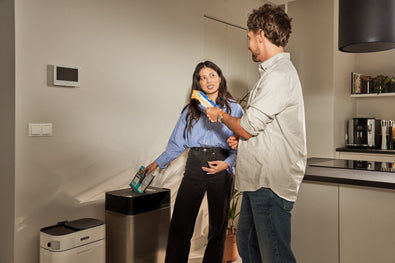
Clear Drop: how we’re revolutionizing home waste management
Read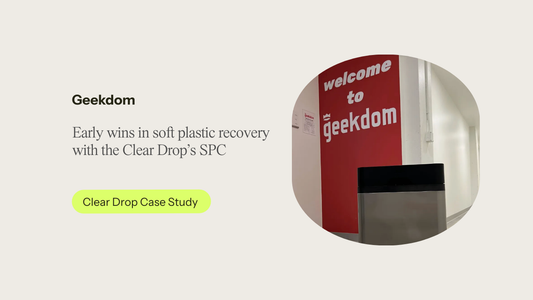
How Geekdom sparked early wins in soft plastic ...
Geekdom is a cornerstone of San Antonio’s startup and innovation ecosystem. Spread across four floors in a prominent downtown building, it houses approximately 40 startups and plays host to a...
Case studyСorporate sustainability
How Geekdom sparked early wins in soft plastic recovery with the Clear Drop's SPC
Geekdom is a cornerstone of San Antonio’s startup and innovation ecosystem. Spread across four floors in a prominent downtown building, it houses approximately 40 startups and plays host to a steady calendar of events: game jams, hackathons, seminars, and tech conferences. It’s the epicenter of the city’s entrepreneurial and venture community. Like many innovation hubs, Geekdom grapples with high volumes of everyday office & food packaging waste. Prior to the pilot, there was no structured process to recover or reduce this plastic waste stream. Pilot goals: Understand employee interest and engagement around soft plastic recycling Measure volume and speed of soft plastic accumulation Evaluate SPC’s role in supporting Geekdom’s broader sustainability and community values Approach Geekdom saw potential in the SPC’s ability to foster a shared community action around sustainability. The device was installed in a common area used by many different startup teams throughout the day, encouraging collaborative stewardship. The pilot was supported by custom signage near the kitchen/break room, table tents on community tables, and direct email outreach to all staff and tenants coordinated with Geekdom’s operations team. Geekdom staff even made their own signage :) Metrics: 1 SPC deployed 2 full soft plastic blocks created in under 2 months Employee participation was tracked qualitatively through conversations and visual observation Improvements are now in the works after receiving awesome critical feedback from staff on signage and the device’s instant recognizability as a recycling device. Materials inserted: Mailers and plastic wrappers from startup equipment Grocery bags, sandwich wrappers, and snack packaging from shared lunches Miscellaneous soft film plastics found around events “As someone who loves to recycle I want this in my home! It’s so easy to use, and gives me a way to recycle what is normally trash” - Julez Perez. Summary Geekdom views the SPC not just as a waste solution but as a community-building tool. In just two weeks, tenants filled a full block with soft plastics, demonstrating both engagement and the real waste footprint of a single floor. The operations team is now in deeper conversations with ClearDrop to potentially expand the pilot to multiple floors. Their slow-roll strategy allows for organic feedback and culture-based insights, helping refine messaging and product design while reinforcing Geekdom’s mission to lead in innovation and sustainability.
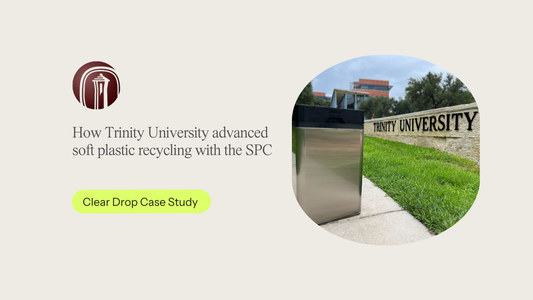
How Trinity University advanced soft plastic re...
Trinity University, a nationally ranked liberal arts institution in San Antonio, Texas, enrolls approximately 2,600 students and maintains a student-to-faculty ratio of roughly 8:1. The university is known for its...
Case studySoft plasticWaste managementСorporate sustainability
How Trinity University advanced soft plastic recycling with the SPC
Trinity University, a nationally ranked liberal arts institution in San Antonio, Texas, enrolls approximately 2,600 students and maintains a student-to-faculty ratio of roughly 8:1. The university is known for its academic rigor, outstanding alumni outcomes, and beautiful, architecturally significant campus. Trinity consistently ranks among the top liberal arts colleges in the country and holds the distinction of being the number one liberal arts university in Texas. Within the Dorothy A. and James W. Laurie Auditorium complex lies the Richardson Communications Center, home to the university’s Department of Communication and KRTU-FM (Jazz 91.7). KRTU is a premier jazz and alternative radio station serving the greater Southwest. It is a campus and community hub where media production, learning, and cultural programming intersect. Laurie Auditorium itself is a 2,700-seat venue that hosts a wide range of events, from academic lectures and commencement ceremonies to public performances, community discussions, and special guest visits. Its high visibility and diverse audience made it an ideal site to explore a new sustainability initiative. Project goals The project sought to embed the SPC (Soft Plastic Compactor) in a dynamic, cross-functional environment. This setting includes: Faculty, who frequent the break room daily Students, particularly those studying communication and media KRTU radio staff, DJs, and student volunteers Guest speakers, special visitors, and artists who appear in academic or media contexts Public guests attending events in Laurie Auditorium The goal was to explore how the SPC performs when used by multiple overlapping groups. This provided an opportunity to test not just the hardware, but also the cultural framing and communications strategy behind it. Soft Plastic Compactor solution An SPC unit was installed in the shared break room within the Communication Department. This space serves as a natural meeting point between academic and media communities, hosting a rotating group of students, professors, radio hosts, station staff, and guests. Clear and approachable signage on the device explained what the SPC is, why it matters, and how to participate. This messaging aligned with the department’s communication values and allowed people to engage with the unit as part of their normal routine. Whether grabbing coffee before class, prepping for a live radio broadcast, or discussing ideas after a lecture, the SPC became a visible part of daily life in the space. "We installed the SPC in our Communication/KRTU break room over the summer, where people actually live their day. Seeing wrappers and film get compacted in seconds is cathartic and it quietly normalizes sustainable behavior" - Dr. Althea Delwiche, Professor & Dept Chair, Department of Communication at Trinity University. SPC use case Primary use area: Shared break room in the Communication Department, located inside the Laurie Auditorium complex. Key user groups: Communication faculty and staff Students and student workers KRTU DJs, station employees, and volunteers Guest speakers and program participants VIPs visiting Laurie Auditorium for cultural or academic events Common soft plastic inputs: Packaging from media and tech equipment Snack wrappers and food-related plastics Film wrap and mailers used in station operations Plastics from hospitality and visitor-related services This variety revealed the types of soft plastic generated in an interdisciplinary learning and production environment, while also demonstrating how accessible the SPC is across user types. Findings and new collaboration perspectives This pilot at Trinity University’s Department of Communication shows how thoughtful placement of the SPC can drive awareness and adoption in spaces where education, media, and public engagement all converge. We are honored to collaborate with such a respected institution and excited for what’s to come. We look forward to expanding our presence within Trinity and across additional departments on campus. Beyond this partnership, we are eager to bring the SPC to other distinguished colleges and universities that share a commitment to sustainability, innovation, and community impact. If your institution is ready to lead by example, we would love to hear from you.
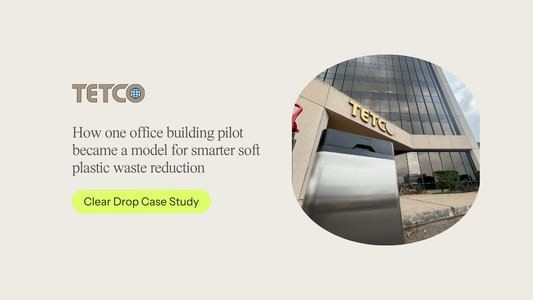
How one office building pilot became a model fo...
In the heart of a major U.S. city, San Antonio, a 10-story commercial office building with up to 30 tenant companies took a step toward smarter sustainability. The building's management...
Case studyWaste managementСorporate sustainability
How one office building pilot became a model for smarter soft plastic waste reduction
In the heart of a major U.S. city, San Antonio, a 10-story commercial office building with up to 30 tenant companies took a step toward smarter sustainability. The building's management sought an effective, hands-on solution to deal with soft plastic waste generated by significant traffic, regular deliveries, and daily office activity. Until recently, the entire building's soft plastic went straight into general waste bins and, inevitably, landfills. Recognizing this recycling gap, the building’s management team agreed to test a new sustainable approach by piloting the Soft Plastic Compactor (SPC) from Clear Drop, a first-of-its-kind device designed specifically to deal with flexible plastics at the point of disposal. The goal: reducing waste and changing behavior Unlike other recycling efforts, soft plastics — such as mailers, wrappers, and packaging — are often overlooked. They’re light, shapeless, and notoriously hard to recycle. Most commercial buildings lack the infrastructure to separate or reallocate these materials. This pilot focused not only on waste reduction but also on behavioral change. The office team wanted to explore how a shared, high-traffic environment would respond to a new type of sustainability intervention. “It’s great to finally see a solution targeting the soft plastic waste we all know ends up in the trash. It's sparked some good conversations among tenants already.” — Tenant feedback, Week 1 The plan: installing an SPC The SPC was installed in a central public area frequented by employees and service staff. Clear signage explained what the device was, what types of plastics it accepts, and why it mattered. There were no lengthy training sessions. This pilot marked a major step forward in testing scale and refining the messaging around the product experience. Initial reactions and feedback Within days, the building began to see early signs of success. Staff and tenants were engaging organically with the machine and showed an increased curiosity about soft plastic use and recycling. Some initial user feedback helped identify opportunities for improvement, such as screen readability and ergonomics, which will inform hardware and signage updates for future pilots. “We didn’t know what to expect, but people started asking about the machine almost immediately. It feels like something new is possible here.” — Building staff comment SPC's immediate impact The building’s management and Clear Drop treated this experience as more than just a test: It was a learning lab. The team monitored how tenants used the SPC, where signage was most effective, and what kinds of plastics were being collected. From the first day, the team witnessed many people inserting a variety of soft plastic materials into the SPC, including: Food wrappers and grocery bags Shipping mailers from business operations Bubble wrap and soft packaging film With the SPC placed in such a central location, the team was able to evaluate not just usage, but also accountability dynamics — such as who is responsible for emptying the unit and what kind of infrastructure is needed to support that. Results: SPC minimized plastic waste and spotlighted sustainability innovation The pilot proved that small actions in shared spaces can create momentum in creating an effective waste management system. The office building’s use of the SPC reduced the volume of soft plastic waste and increase its recyclability. It also raised awareness, invited participation, and planted the seed for broader adoption. Management now sees the SPC as a valuable amenity — a simple yet powerful way to show tenants they care about environmental impact, innovation, and accountability. And most importantly, it’s a system that works, even in places not designed for sorting plastics. This multi-tenant office pilot is setting the template for wider-scale SPC rollouts. It’s the first deployment where product-market fit, setting, and communication all aligned for a full learning loop. We are still analyzing more long-term results , but the initial response from tenants and staff shows promise. The building's team sees the SPC not only as a sustainability tool but as a way to boost tenant engagement and reduce overall plastic waste.
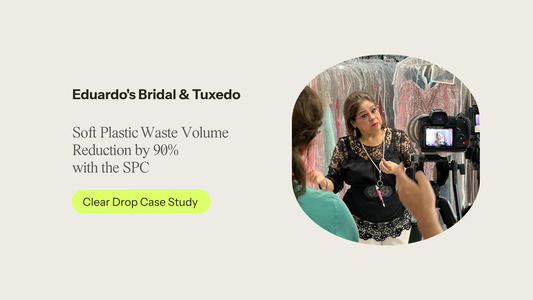
How Eduardo's Bridal & Tuxedo reduced soft plas...
At Eduardo’s Bridal & Tuxedo, elegance comes wrapped, quite literally, in plastic. From delivery to post-cleaning storage, each rented garment arrives sealed in soft plastic film. It’s a common industry...
Case studySoft plasticСorporate sustainability
How Eduardo's Bridal & Tuxedo reduced soft plastic waste volume by 90% with the SPC
At Eduardo’s Bridal & Tuxedo, elegance comes wrapped, quite literally, in plastic. From delivery to post-cleaning storage, each rented garment arrives sealed in soft plastic film. It’s a common industry practice, but one that generates a surprising volume of waste. That’s why we partnered with the team at Eduardo’s to install the Soft Plastic Compactor (SPC) and explore how a small shift in waste management could close the loop on this hidden waste stream. Challenging soft plastic packaging waste Eduardo's Bridal & Tuxedo is a long-standing, family-owned formalwear business based in San Antonio, Texas. With two locations and over 35 years of service, they specialize in bridal gowns, tuxedos, and quinceañera dresses, offering in-house tailoring and fitting services. Despite a commitment to customer care and local community engagement, Eduardo’s faced a persistent problem: high volumes of flexible plastic waste. Plastic packaging from gowns, dress bags, flexible plastics on tuxedos, and garment wrap contributed to a growing and inefficient waste stream."Customers care about sustainability, especially younger clients. The Soft Plastic Compactor helps us show we’re listening and acting. It’s an elegant solution for a messy problem." — Eduardo D., founder & CEO. Historically, this waste was sent to landfills due to limited soft plastic recycling access in the region. With increasing waste management costs and a desire to improve sustainability, Eduardo’s partnered with Clear Drop to pilot the Soft Plastic Compactor (SPC). Solution Over two months, Clear Drop worked closely with Eduardo’s team at their primary San Pedro Avenue location in San Antonio. We installed the SPC right where the waste happens: in the back-room storage and fitting area. The staff received hands-on training, and we set up clear signage guides to make using the device easy and intuitive. "It was easy to get the team onboard. We generate so much plastic packaging just unboxing dresses. It was great to finally have something to do with it besides toss it." — Laura D., store manager. Over the course of the pilot, we saw how quickly the SPC became part of the daily routine. Staff began collecting garment bags and packaging film in one place, compacting them into dense blocks ready for real recycling. Instead of piling up in bins or ending up in landfills, these materials are now on their way to our recycling partners to be transformed into useful new products. In just two months, the SPC helped Eduardo’s team significantly reduce their soft plastic waste volume. Based on their usage, the store is projected to generate around 20 pounds of flexible plastic packaging per month, now compacted into just two dense blocks. This means nearly 90% less volume compared to loose bagged waste, freeing up storage space and making recycling easier, cleaner, and, most importantly, manageable with Clear Drop partners. Soft Plastic Compactor use case Eduardo's Bridal & Tuxedo discovered the SPC through a local sustainability-focused business group. Their interest stemmed from the need to reduce overflowing bags-within-bags and make their operations visibly greener for eco-conscious customers. Throughout the pilot, the team collected: Garment plastic bags Shrink wrap from formalwear shipments Plastic film from accessory packaging Dry-cleaning bags Each SPC block was then stored in a labeled collection bin and picked up monthly for proper downstream soft plastic recycling."It’s small, quiet, and honestly kind of satisfying to use. Makes us feel like we’re part of the solution, not just the problem." — Sylvia B., sales manager. Results Eduardo’s Bridal & Tuxedo sees the SPC as a smart, hands-on tool to manage a difficult waste stream. It brought their sustainability intentions to life in a way that customers could see and staff could engage with. The feedback from Eduardo’s team has helped us refine how we support service businesses where plastic waste is part of the process, not the product. The business is considering rolling out the SPC to its second location and adding signage to educate customers about what happens to the compacted flexible plastics with the SPC soft plastic recycling system, reinforcing their brand’s modern and responsible image.
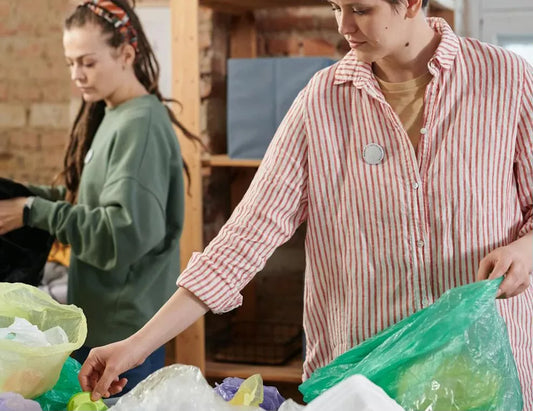
Why business recycling matters: a key to corpor...
Corporate sustainability has become a major component of any company’s ESG (environmental, social, and governance) program and has become a fundamental aspect of their overall business strategy. Corporate sustainability influences...
Waste managementСorporate sustainability
Why business recycling matters: a key to corporate sustainability
Corporate sustainability has become a major component of any company’s ESG (environmental, social, and governance) program and has become a fundamental aspect of their overall business strategy. Corporate sustainability influences the hiring process, partnership deals, and company image. Business recycling has emerged as a crucial element, helping companies reduce waste, minimize their environmental impact, and align with ESG principles. This is not only true for large corporations with formal corporate sustainability programs, but also for small to medium size companies looking to minimize their environmental footprint and align more closely with customer and employee expectations. Corporate sustainability: satisfy both employees and customers Business sustainability practices are an essential part of corporate culture and necessary to attract top talent. A recent study by PwC revealed that "68% of job candidates say that environmental practices are important in choosing an employer". Employees want their companies to invest in sustainability efforts, including reducing carbon, using renewable energy, and reducing waste. Moreover, a Deloitte study found that most employees believe their companies should contribute more to addressing climate change and sustainability. Two-thirds of employees globally report that they do not think their employers are doing enough to address climate change and don’t have enough business sustainability practices. In addition, more and more consumers expect companies to be more active in sustainability efforts. Forbes reports that "87% of consumers have a more positive image of a company that supports social or environmental issues". Consumer behavior also shows a trend in sustainable purchases and willingness to pay more for sustainable products. According to Nielsen, "55% of consumers are willing to pay more for products and services provided by companies that are committed to a positive social and environmental impact". And about half of respondents (47%) in a Deloitte survey, Sustainable Consumption Trends, said they had purchased a sustainable good in the last four weeks. Expanding sustainability: beyond carbon to business recycling As companies strive to meet ESG goals and reduce their environmental footprint, business recycling and waste stream management programs are becoming essential. According to EPA data, 75% of the American waste stream is recyclable, but only about 30% of it is recycled. While businesses produce about 25% of all the world’s waste every year, business recycling rates tend to be lower than residential. The growing plastic waste crisis More than 95% of plastics generated are put in a landfill or incinerated for energy. The EPA also revealed that while plastic recycling is on the decline, the per capita generation of plastic waste increased by 263% since 1980. And what about soft plastic-- or film plastic? McKinsey reports recycling rates well below 10 percent, although plastic film recycling is not widely tracked and reported. Soft plastic tends to reduce the efficiency of recycling other types of plastic, since it disrupts the sorting process when it is co-mingled with plastic bottles and other semi-rigid plastics. Business recycling programs Businesses across various industries have implemented waste management programs that not only mitigate waste generation but also promote recycling, reusing materials, and fostering circular economy principles. Corporate: many companies, such as Apple, have set ambitious landfill diversion goals. Apple has committedto becoming carbon neutral for corporate operations and aspires to divert over 74% of its waste from landfills through their business recycling and reuse programs. Healthcare: University of Michigan (U-M) Health has completed a plastics recycling program at Mott Children’s hospital and the Von Voigtlander Women’s hospital. Operating room plastic was collected over a 6-month period and U-M was able to divert 2.64 tons of plastic from landfills. The program is now permanent and will be expanding. Higher Education: Virginia Tech, University of Richmond and Arizona State University are three examples of the many colleges focused on collecting and recycling soft plastic waste. Examples of film and soft plastics collected: air pillows, bread bags, bubble wrap, produce bags and shrink wrap. How to set up waste recycling programs for your business Setting up a comprehensive recycling program involves several key steps: 1. Conduct a waste audit: Check the types and quantities of waste that your company produces. This will provide a better understanding of these waste streams and the resources needed to better address them. 2. Separate recyclables: collect each type of waste separately including plastics, organics, glass, metal, cardboard and paper, and electronics. 3. Educate employees: Employee engagement is crucial. Create recycling educational programs to raise awareness and communicate how they can and should recycle at their workplace. Create easy access to recycling bins as well as simple instructions on what is recyclable and where it should be placed. 4. Set clear goals: Set specific goals for waste recycling, such as diverting 50% of your waste from landfills. Track your progress and share with your team regularly to ensure you’re moving forward with your targets.5. Collaborate with certified recycling facilities: Negotiate with local recycling centers that are certified to process specific types of waste. Ensure that they are capable of recycling the materials you are collecting. 6. Invest in technology: For some companies, the complexities of recycling in the workplace may limit employee participation. Leverage online and app-based training tools to educate employees. Further, emerging innovative technologies are also enabling a shift towards a more convenient and circular approach in recycling programs. Smart solutions for efficient plastic waste management A new, innovative solution is now available that can help bolster your business recycling program by making your soft plastic waste collection more efficient and preparing it to be recycled more easily. The Clear Drop® Soft Plastic Compactor (SPC) is the first business and home appliance to simplify soft plastic collection and ensure it all goes to recycling. The SPC transforms fluffy plastic packaging into a space-saving 12×8×4-inch block. The plastic brick is then processed at a dedicated recycling facility, using environmentally safe methods to give your plastics a second life and ensure the efficiency of your recycling programs. As businesses continue to implement sustainable practices like comprehensive recycling and waste management programs, the focus on diverting plastic and other waste from landfills becomes increasingly important. Through innovative technologies, employee engagement, and organized programs, companies can reduce waste, meet landfill diversion goals, and enhance their corporate sustainability efforts. Savvy companies are recycling more; because customers expect it and employees want to be part of it.

